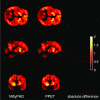NiftyPAD - Novel Python Package for Quantitative Analysis of Dynamic PET Data
- PMID: 36622500
- PMCID: PMC10085912
- DOI: 10.1007/s12021-022-09616-0
NiftyPAD - Novel Python Package for Quantitative Analysis of Dynamic PET Data
Abstract
Current PET datasets are becoming larger, thereby increasing the demand for fast and reproducible processing pipelines. This paper presents a freely available, open source, Python-based software package called NiftyPAD, for versatile analyses of static, full or dual-time window dynamic brain PET data. The key novelties of NiftyPAD are the analyses of dual-time window scans with reference input processing, pharmacokinetic modelling with shortened PET acquisitions through the incorporation of arterial spin labelling (ASL)-derived relative perfusion measures, as well as optional PET data-based motion correction. Results obtained with NiftyPAD were compared with the well-established software packages PPET and QModeling for a range of kinetic models. Clinical data from eight subjects scanned with four different amyloid tracers were used to validate the computational performance. NiftyPAD achieved [Formula: see text] correlation with PPET, with absolute difference [Formula: see text] for linearised Logan and MRTM2 methods, and [Formula: see text] correlation with QModeling, with absolute difference [Formula: see text] for basis function based SRTM and SRTM2 models. For the recently published SRTM ASL method, which is unavailable in existing software packages, high correlations with negligible bias were observed with the full scan SRTM in terms of non-displaceable binding potential ([Formula: see text]), indicating reliable model implementation in NiftyPAD. Together, these findings illustrate that NiftyPAD is versatile, flexible, and produces comparable results with established software packages for quantification of dynamic PET data. It is freely available ( https://github.com/AMYPAD/NiftyPAD ), and allows for multi-platform usage. The modular setup makes adding new functionalities easy, and the package is lightweight with minimal dependencies, making it easy to use and integrate into existing processing pipelines.
Keywords: NiftyPAD; PET; Pharmacokinetic analysis; Python package; Reference input-based modelling.
© 2023. The Author(s).
Conflict of interest statement
The authors have no competing interests to declare that are relevant to the content of this article.
Figures

 , including optional motion correction, reference input processing, a group of kinetic modelling methods and weighting schemes for analysing dynamic PET data. The required user inputs are shaded in
, including optional motion correction, reference input processing, a group of kinetic modelling methods and weighting schemes for analysing dynamic PET data. The required user inputs are shaded in
 , the intermediate data in
, the intermediate data in
 , and the resulting outcome measures in
, and the resulting outcome measures in










References
-
- Boellaard R, Yaqub M, Lubberink M, Lammertsma A. Ppet: A software tool for kinetic and parametric analyses of dynamic PET studies. NeuroImage. 2006;31(Supplement 2):62. doi: 10.1016/j.neuroimage.2006.04.053. - DOI
Publication types
MeSH terms
LinkOut - more resources
Full Text Sources

